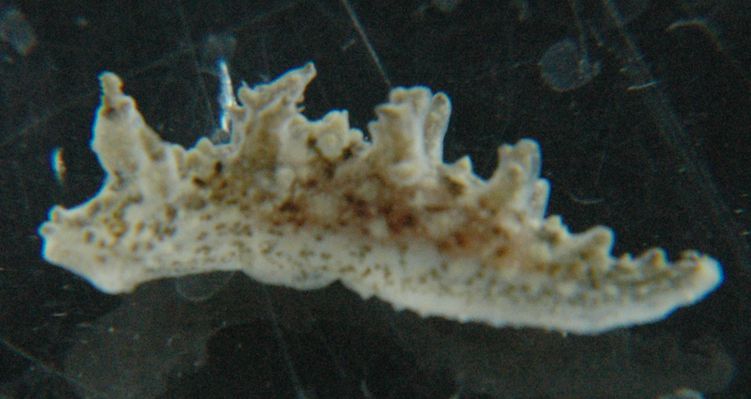Dendronotus frondosus (Ascanius, 1774)Common name(s): Frond-aeolis, bushy-backed nudibranch, leafy dendronotid, branched dendronotus |
|
| Synonyms: Amphitrite frondosa, Dendronotus arborescens, D. venustus |  |
|
Class Gastropoda
Family Dendronotidae
|
|
| Dendronotus frondosus, about 2 cm long, which came through the Rosario Beach Marine Lab seawater system. Probably brought into intakes as a pelagic larva and partly grew in system before flushing out. | |
| (Photo by: Dave Cowles, August 2014 ) | |
Description: Dendronotids have the anus is on the right side of the body (photo) and the dorsum has cerata or gills. If cerata, they are usually in 2 dorsolateral longitudinal rows. The clavus of the rhinophores can be fully or at least partly retracted into a sheath. Dendronotus frondosus has two dorsolateral rows of bushy cerata (3 to 9 pairs) but has a rounded, sluglike dorsum with no obvious dorsolateral margins. It has no large oral hood. The small oral veil has 4 pairs of simply branched papillae, and there are up to 6 simple papillae on the lips. The rhinophores have a perfoliateclavus and the rhinophoresheath has a series of papillae that make it look like a crown. The rhinophore stalks do not have any posterior bushy outgrowths but they do have one or more small lateral papillae (photo). The 5-7 pairs of cerata are moderately branched. The foot has no white line around the edge of it, and there is no white line along the dorsal midline of the tail (photo). The body color is gray to greenish to dark reddish brown, often with yellow, green, or brown flecks on the body (photo). Maximum length 5 cm, but usually 1.5 to 3 cm.
How to Distinguish from Similar Species:Dendronotus albus and D. diversicolor have lighter body color and white or orange tips on the cerata. Dendronotus rufus has a red line around the foot.
Geographical Range: Cosmopolitan in North Temperate oceans; from northern Alaska to northern Mexico on our Pacific coast.
Depth Range: Intertidal to 400 m
Habitat: Around hydroids
Biology/Natural History:
This species
feeds on a variety of hydroids such as Abietenaria, Obelia,
and Aglaophenia.
| Return to: | |||
| Main Page | Alphabetic Index | Systematic Index | Glossary |
References:
Dichotomous Keys:Carlton, 2007
Kozloff, 1987, 1996
General References:
Behrens
and Hermosillo, 2005
Lamb
and Hanby, 2005
Morris
et al., 1980
Scientific Articles:
Web sites:
General Notes and Observations: Locations, abundances, unusual behaviors:
Several of these came through the Rosario Beach Marine Lab
seawater
system in 2014. The animal is too large to make it through
the intake
screens, and the screens are about 1.5 m off the bottom so it must have
entered the system as a pelagic
larva, then resided in the reservoir tank and grown a bit before being
flushed out into our tanks.

In this view of the front right side of the body, the anus which is
on the right side close behind the rhinophores
can be clearly seen. The yellow and brown spots are also
plainly
visible.
Note the small lateral papilla
on the stalk of the rhinophore.
This view of the tail shows that it has no white line along its dorsal midline.
The heartbeat of
this species, as seen by the
pulsing of a cluster of short dorsomedial papillae
behind the first pair of cerata, is plainly visible in this
movie.
Authors and Editors of
Page:
Dave Cowles (2014): Created original page
CSS coding for page developed by Jonathan Cowles (2007)
Salish Sea Invertebrates web site provided courtesy of Walla
Walla University
